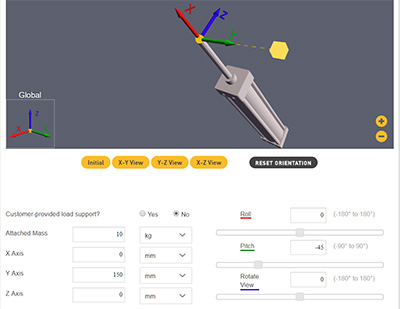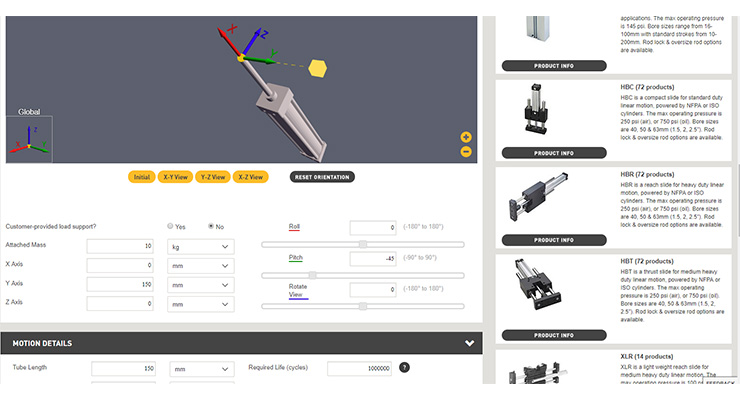A new motion control design tool for engineers from Parker Hannifin Corp. aims to help with the proper selection of electromechanical and pneumatic linear motion. Dubbed Virtual Engineer, the free online tool is an intuitive interface where users can easily enter their application specifications, (for example, speed, load, external forces) and then quickly navigate to accurately sized product options.
The tool delivers a custom specification report, CAD models, and seamlessly creates a ready to issue “request for quote” (RFQ). By connecting directly with Parker motion control experts, Virtual Engineer takes collaboration to a whole new level, and by doing so, helps to increase efficiency of your own valuable engineering resources.
 Parker’s Steve Whyte, Product Sales Manager – Pneumatic Division North America, said there is no other tool like this on the market for specifying either pneumatic or electromechanical technologies. This tool actually simulates how Parker’s products will work in a user’s specific application, not just give rated data.
Parker’s Steve Whyte, Product Sales Manager – Pneumatic Division North America, said there is no other tool like this on the market for specifying either pneumatic or electromechanical technologies. This tool actually simulates how Parker’s products will work in a user’s specific application, not just give rated data.
“It can be challenging for our customers to get from an application through to a final product because there’s a lot of technical calculations” that must be considered, Whyte said.
“There’s a trend of manufacturers, machine builders, and OEMs trying to offload their engineering complexity and their engineering work onto their suppliers. So we thought, how do we streamline that process and save some of the cost that is incurred every time we have a design engineer have to go through that process while also minimizing design time,” he continued.
Whyte added that requiring engineers or anyone who may be specifying a product to review catalogs, online configurators and other sizing tools makes it difficult to understand how the product is really going to work in their application. There’s also a confidence factor of knowing whether the customer has selected the right component.
 “We need to solve this problem,” Whyte said. “The goal is to provide something that is extremely simple and extremely intuitive. We have taken all those complicated calculations and built them into the software so now you don’t have to think about how I do convert a force to a moment or calculate my total time of travel, you’re just looking at simple questions as you go through and we’re thinking about every single potential variable.”
“We need to solve this problem,” Whyte said. “The goal is to provide something that is extremely simple and extremely intuitive. We have taken all those complicated calculations and built them into the software so now you don’t have to think about how I do convert a force to a moment or calculate my total time of travel, you’re just looking at simple questions as you go through and we’re thinking about every single potential variable.”
Virtual Engineer includes many customer-focused features including product life estimation, “Compare” function for multiple products, CAD model availability, and a “My Projects” area. My Projects allows engineers to create, save, and share projects. The simple graphical interface allows the user to input details on attached mass, external forces and moments, plus axis orientation, motion details, filter by key attributes, or explore all solutions with minimal required inputs.
As application parameters are applied, a list of possible solutions is presented on your screen. If any specification exceeds a solution’s capability, it is eliminated from the available options in real time. After completing all specifications, Virtual Engineer’s “Compare” feature will display clearly the differences between the most suitable products, including expected life and relative cost. This information can then be saved, downloaded, or submitted to Parker for a price quote.
Essentially, it reviews thousands of products, using the specific inputs and requirements you’ve entered, and returns a list of products capable of handling your application.
Virtual Engineer currently supports Parker Electromechanical and Pneumatic products.
Parker Hannifin
solutions.parker.com/virtualengineer
Filed Under: Pneumatic Tips